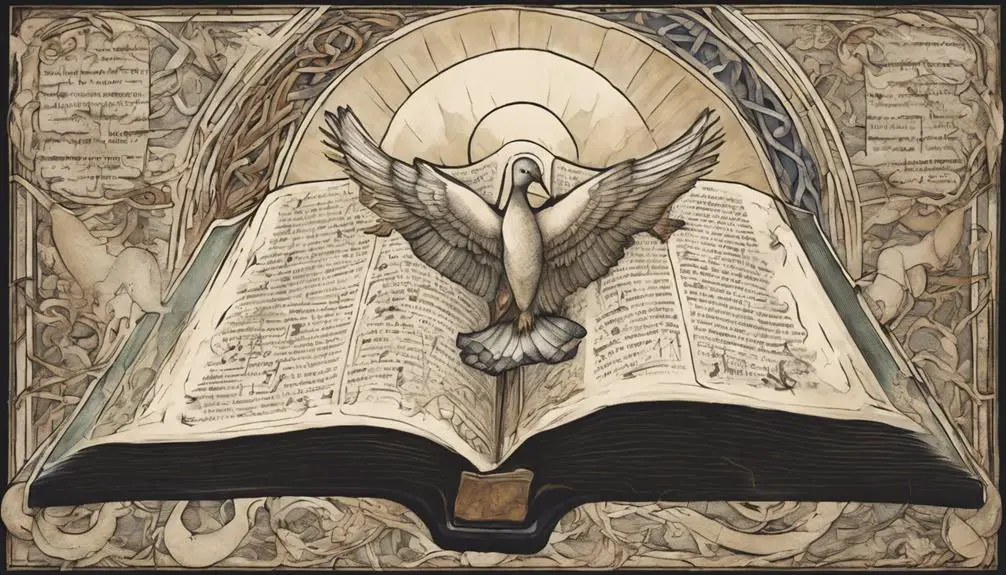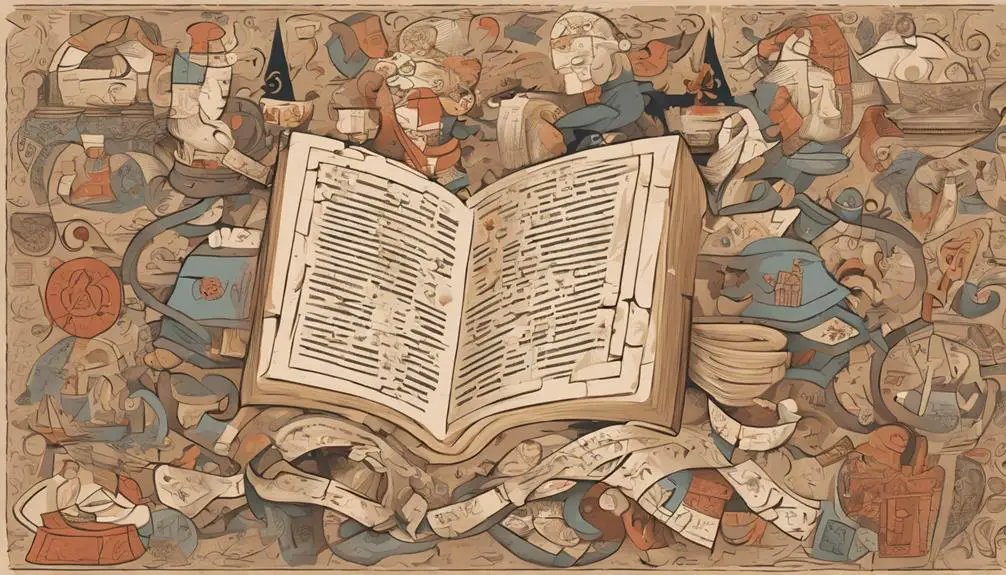Journey through the intriguing exploration of 50,000 alleged mistakes in the Bible, revealing complexities that challenge and enlighten readers.

50000 Mistakes in the Bible
Have you ever pondered how a book as widely revered as the Bible could harbor 50,000 mistakes? Navigating through historical inaccuracies, contradictions, translation errors, scientific discrepancies, and more, you'll find this exploration both enlightening and challenging.
As you embark on this journey, remember, understanding these supposed errors can deepen your appreciation of the Bible's complexity and its impact over millennia.
So, let's tread carefully on this path, armed with curiosity and an open mind, to uncover what lies beneath the surface of these controversies.
Key Takeaways
- Discrepancies in the Bible often stem from historical and geographical inaccuracies.
- Ethical and genealogical contradictions reflect the complexity of ancient oral traditions.
- Translation and interpretation challenges contribute to perceived mistakes.
- Scientific and cosmological discrepancies highlight the gap between ancient beliefs and modern understanding.
Historical Inaccuracies Explored

The examination of historical inaccuracies within the Bible reveals a complex interplay between ancient narrative traditions and archaeological evidence. You'll find that two of the most significant areas where inaccuracies have been identified are geographical errors and chronological issues. These discrepancies don't just challenge the historical accuracy of the texts but also offer insights into the context in which these stories were written and transmitted.
Geographical errors in the Bible aren't uncommon, considering the vast span of time and the oral traditions through which these stories were passed before being written down. You might encounter descriptions of locations that either don't match current archaeological understanding or, in some cases, seem not to exist at all as described. These inaccuracies suggest that the authors of the Bible, while inspired, were also products of their time, relying on second-hand reports or outdated maps.
Chronological issues are equally telling. The Bible's timeline of events, especially in the Old Testament, often doesn't align with established historical timelines derived from archaeological findings and external historical records. For instance, the dates of significant events like the Exodus or the reign of certain kings can be hard to reconcile with Egyptian or Mesopotamian chronologies.
Understanding these inaccuracies doesn't diminish the Bible's value as a religious text but rather enriches your understanding of it as a document of its time. It's a reminder that the Bible, while sacred to many, is also a historical artifact shaped by human hands, reflecting the knowledge, beliefs, and limitations of its authors.
Contradictions Within the Scriptures

Exploring historical inaccuracies provides a foundation for understanding contradictions within the scriptures, which further challenge and illuminate the complexity of the biblical narrative. You'll find that delving into these contradictions isn't merely an exercise in pointing out flaws but rather a journey into understanding the multifaceted nature of these ancient texts. Among these contradictions, genealogical discrepancies and ethical dilemmas are particularly noteworthy, each adding layers of complexity to biblical interpretation.
Genealogical discrepancies aren't mere oversights; they're windows into the evolving nature of oral and written traditions. You'll notice, for instance, variations in the lineage of key figures across different books, suggesting a fluidity in how ancestries were recorded and remembered. These discrepancies don't just highlight inconsistencies; they invite you to consider the context in which these narratives were constructed and transmitted.
Ethical dilemmas, on the other hand, reflect the diverse perspectives and moral landscapes within the Bible itself. You're faced with instances where actions deemed righteous in one context are condemned in another, challenging you to grapple with the relative nature of morality within the text. These dilemmas aren't simply contradictions for the sake of contradiction; they're reflective of the complex human experiences and moral questions that the scriptures aim to address.
In examining these contradictions, you're not just identifying errors. You're engaging with the depth and breadth of biblical literature, appreciating its complexities, and acknowledging its capacity to inspire reflection on genealogy, ethics, and beyond.
Translation and Interpretation Errors

Beyond genealogical discrepancies and ethical dilemmas, you'll encounter translation and interpretation errors that significantly alter the understanding of biblical texts. The Bible, an ancient compilation of texts, has been translated into numerous languages over centuries. Each translation carries the risk of misinterpreting the original language's linguistic nuances and idiomatic expressions, leading to a potential shift in the scripture's intended meaning.
Linguistic nuances, particularly in ancient languages like Hebrew, Aramaic, and Greek, play a crucial role in the precise conveyance of messages. These languages often contain words and phrases with multiple meanings or with significance rooted in cultural contexts that are challenging to translate accurately into modern languages. For instance, the Hebrew word 'day' can mean a 24-hour period or a longer, indefinite period, depending on the context. Misinterpretation of such words can lead to differing understandings of timelines and events described in the Bible.
Furthermore, idiomatic expressions, which are phrases that don't mean what they literally say, pose another significant challenge. For example, certain expressions used in the original texts might've been understood by contemporary readers but lose their intended meaning when translated directly into another language without considering the cultural and linguistic context.
Thus, when exploring biblical texts, it's essential to consider the impact of translation and interpretation errors. These errors can lead to misunderstandings of doctrine, prophecy, and historical accounts, emphasizing the importance of careful, scholarly analysis in translating and interpreting these ancient writings.
Scientific Discrepancies Highlighted

Analyzing scientific discrepancies in the Bible reveals a complex interplay between ancient texts and modern scientific understanding. These discrepancies often hinge on the Bible's descriptions of the natural world and cosmos, which, when examined through the lens of contemporary science, don't always align with our current understanding. This divergence invites a nuanced examination of how ancient cosmological models and views on species taxonomy contrast with today's scientific consensus.
- Cosmological Models: Ancient texts, including the Bible, present a cosmology that's vastly different from the heliocentric model supported by contemporary astronomy. The Bible's depiction of a flat Earth with a firmament overhead reflects the prevailing cosmological view of the time, rather than the spherical Earth orbiting the sun that we understand today.
- Species Taxonomy: The Bible's categorization of living organisms doesn't align with modern species taxonomy. For instance, bats are classified as birds in Leviticus, a classification that contradicts current biological taxonomy where bats are recognized as mammals.
- Global Flood: The narrative of a global flood as described in Genesis poses significant geological and archaeological questions. Modern geology and paleontology don't support the feasibility of such an event in the manner and timeline described.
- Creation Timeline: The six-day creation timeline contradicts the vast timescales established by cosmology and evolutionary biology for the formation of the universe and the evolution of life on Earth.
These discrepancies highlight the importance of viewing the Bible through the lens of its historical and cultural context, acknowledging the gap between ancient understandings and modern scientific methodologies.
Contextual and Cultural Misunderstandings

Many passages in the Bible, when stripped of their cultural and historical context, can lead to significant misunderstandings. It's important to recognize how linguistic evolution and symbolic interpretations play crucial roles in how we perceive these ancient texts today. Without understanding the original cultural and societal norms, modern readers may misinterpret messages that were clear to ancient audiences.
The Bible is a collection of texts written over centuries, each with its own cultural backdrop. As languages evolve, the meanings of words can shift dramatically, leading to potential misinterpretations. Furthermore, many stories and teachings in the Bible use symbolism that was deeply rooted in the cultural understanding of the time. Without grasping these symbolic meanings, one might miss the intended messages.
Here is a table illustrating examples of common misunderstandings and their causes:
Biblical Concept |
Common Misunderstanding |
Explanation |
|---|---|---|
Camel through the eye of a needle |
Literal impossibility |
Symbolic expression for difficulty |
Washing of feet |
Mere hospitality |
Deep act of humility and service |
Levirate marriage |
Strange custom |
Social security for widows |
Mustard seed |
Literal smallest seed |
Symbolic of small beginnings |
Manuscript Variants and Their Impact

The investigation of manuscript variants reveals how differences in biblical texts can significantly affect their interpretation and understanding. Textual criticism, a scholarly field dedicated to examining these variants, seeks to identify and explain the discrepancies among the myriad of biblical manuscripts. Through careful analysis, scholars aim to reconstruct the most accurate version of the text. Scribal practices, including copying errors, intentional alterations, and regional linguistic variations, have contributed to the diversity seen in manuscript traditions.
Understanding the impact of manuscript variants involves recognizing several key points:
- Historical Context: Variants can provide insight into the historical context in which scribes worked, including the technological, cultural, and theological influences on their copying practices.
- Theological Implications: Differences in wording or the inclusion/exclusion of certain passages can have profound theological implications, affecting doctrines and interpretations.
- Textual Reliability: The sheer volume of manuscripts and their variants demonstrates both the challenges and the robustness of textual criticism in establishing a reliable biblical text.
- Reader Interpretation: Variants can influence how modern readers understand biblical narratives, teachings, and prophecies, highlighting the dynamic interaction between text, tradition, and interpretation.
In essence, manuscript variants aren't mere errors but are windows into the complex process of biblical transmission. They underscore the meticulous work of textual critics in bridging the gap between ancient scribal practices and contemporary biblical scholarship. By understanding these variants, you gain a deeper appreciation for the historical, theological, and textual richness of the Bible.
Frequently Asked Questions
How Do Different Religious Denominations Address and Reconcile the Identified Mistakes in the Bible?
When exploring how religious denominations address and reconcile differences in biblical texts, it's key to focus on textual variants and interpretive differences.
You'll find that denominations often rely on scholarly analysis and historical context to understand these variations. They may view them not as mistakes, but as opportunities to deepen understanding.
Through dialogue and study, these communities work to reconcile divergent interpretations, aiming to maintain a cohesive faith narrative.
How Have These Purported Mistakes Impacted the Faith and Beliefs of Individual Believers and Congregations?
You might think that errors would weaken faith, but for many, they've deepened understanding. When examining how these inaccuracies affect beliefs, it's crucial to consider historical context and cultural perspectives. These elements often illuminate why discrepancies exist, helping believers and congregations navigate their faith with more depth.
Analyzing these impacts objectively reveals a complex relationship between faith practices and perceived inaccuracies, enriching rather than diminishing spiritual journeys.
In What Ways Have Modern Technologies, Such as AI and Digital Manuscripts, AIded in the Discovery and Analysis of These Mistakes?
Modern technologies, like AI and digital manuscripts, have revolutionized textual criticism. They've enabled scholars to analyze manuscript variability with unprecedented precision.
You'll find that these tools have made it easier to identify and understand variations within texts, enhancing the accuracy of interpretations.
This hasn't only streamlined research but also deepened our understanding of historical documents' evolution over time, offering a clearer picture of their original context and meaning.
Are There Any Notable Examples Where a "Mistake" in the Bible Has Led to Significant Changes in Theological Doctrine or Church Practices?
You're asking if any notable examples exist where errors have significantly impacted theological doctrine or church practices.
Yes, translation errors and historical inaccuracies have played such roles.
For instance, translation mistakes in early Bible versions affected interpretations of key doctrines, leading to debates and revisions in church teachings.
Similarly, discoveries of historical inaccuracies have prompted reevaluations of certain biblical narratives, influencing how traditions and practices are understood and enacted within various Christian communities.
How Do the Identified Mistakes in the Bible Compare to Those Found in Other Sacred Texts From Different Religions?
Just as a gardener finds weeds among the flowers, textual analysis in comparative theology uncovers discrepancies in sacred texts across religions. These 'mistakes' vary widely, reflecting the diverse contexts and histories of each tradition.
Through scholarly scrutiny, it's evident that no text is free from human error. However, the impact and interpretation of these errors differ, revealing unique insights into the beliefs and practices of each faith community.
Conclusion
In the vast landscape of biblical scholarship, you've navigated through a forest of 50,000 errors, from historical inaccuracies to contradictions, and from translation mishaps to scientific disputes.
Like an explorer deciphering ancient maps, you've seen how contextual and cultural misunderstandings, alongside manuscript variants, weave a complex tapestry of interpretation.
This journey illuminates not just the flaws within the sacred texts but also the human endeavor to understand, translate, and apply these ancient narratives within our evolving world.



Sign up